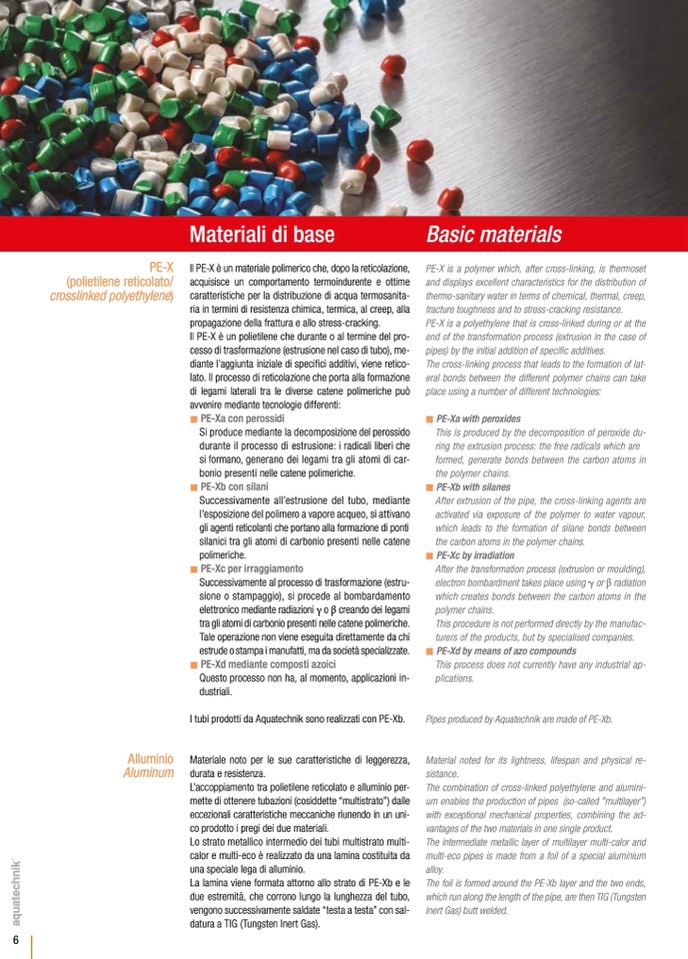


Il PE-X è un materiale polimerico che, dopo la reticolazione,
acquisisce un comportamento termoindurente e ottime
caratteristiche per la distribuzione di acqua termosanita-
ria in termini di resistenza chimica, termica, al creep, alla
propagazione della frattura e allo stress-cracking.
Il PE-X è un polietilene che durante o al termine del pro-
cesso di trasformazione (estrusione nel caso di tubo), me-
diante l’aggiunta iniziale di specifici additivi, viene retico-
lato. Il processo di reticolazione che porta alla formazione
di legami laterali tra le diverse catene polimeriche può
avvenire mediante tecnologie differenti:
PE-Xa con perossidi
Si produce mediante la decomposizione del perossido
durante il processo di estrusione: i radicali liberi che
si formano, generano dei legami tra gli atomi di car-
bonio presenti nelle catene polimeriche.
PE-Xb con silani
Successivamente all’estrusione del tubo, mediante
l’esposizione del polimero a vapore acqueo, si attivano
gli agenti reticolanti che portano alla formazione di ponti
silanici tra gli atomi di carbonio presenti nelle catene
polimeriche.
PE-Xc per irraggiamento
Successivamente al processo di trasformazione (estru-
sione o stampaggio), si procede al bombardamento
elettronico mediante radiazioni γ o β creando dei legami
tra gli atomi di carbonio presenti nelle catene polimeriche.
Tale operazione non viene eseguita direttamente da chi
estrude o stampa i manufatti, ma da società specializzate.
PE-Xd mediante composti azoici
Questo processo non ha, al momento, applicazioni in-
dustriali.
I tubi prodotti da Aquatechnik sono realizzati con PE-Xb.
Materiale noto per le sue caratteristiche di leggerezza,
durata e resistenza.
L’accoppiamento tra polietilene reticolato e alluminio per-
mette di ottenere tubazioni (cosiddette “multistrato”) dalle
eccezionali caratteristiche meccaniche riunendo in un uni-
co prodotto i pregi dei due materiali.
Lo strato metallico intermedio dei tubi multistrato multi-
calor e multi-eco è realizzato da una lamina costituita da
una speciale lega di alluminio.
La lamina viene formata attorno allo strato di PE-Xb e le
due estremità, che corrono lungo la lunghezza del tubo,
vengono successivamente saldate “testa a testa” con sal-
datura a TIG (Tungsten Inert Gas).
PE-X is a polymer which, after cross-linking, is thermoset
and displays excellent characteristics for the distribution of
thermo-sanitary water in terms of chemical, thermal, creep,
fracture toughness and to stress-cracking resistance.
PE-X is a polyethylene that is cross-linked during or at the
end of the transformation process (extrusion in the case of
pipes) by the initial addition of specific additives.
The cross-linking process that leads to the formation of lat-
eral bonds between the different polymer chains can take
place using a number of different technologies:
PE-Xa with peroxides
This is produced by the decomposition of peroxide du-
ring the extrusion process: the free radicals which are
formed, generate bonds between the carbon atoms in
the polymer chains.
PE-Xb with silanes
After extrusion of the pipe, the cross-linking agents are
activated via exposure of the polymer to water vapour,
which leads to the formation of silane bonds between
the carbon atoms in the polymer chains.
PE-Xc by irradiation
After the transformation process (extrusion or moulding),
electron bombardment takes place using or β radiation
which creates bonds between the carbon atoms in the
polymer chains.
This procedure is not performed directly by the manufac-
turers of the products, but by specialised companies.
PE-Xd by means of azo compounds
This process does not currently have any industrial ap-
plications.
Pipes produced by Aquatechnik are made of PE-Xb.
Material noted for its lightness, lifespan and physical re-
sistance.
The combination of cross-linked polyethylene and alumini-
um enables the production of pipes (so-called “multilayer”)
with exceptional mechanical properties, combining the ad-
vantages of the two materials in one single product.
The intermediate metallic layer of multilayer multi-calor and
multi-eco pipes is made from a foil of a special aluminium
alloy.
The foil is formed around the PE-Xb layer and the two ends,
which run along the length of the pipe, are then TIG (Tungsten
Inert Gas) butt welded.
6



